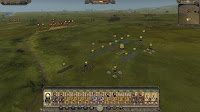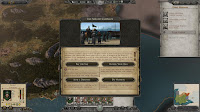Age of Charlemagne is a new
campaign DLC for Total War: Attila. Set at the dawn of the great
medieval kingdoms, Charlemagne plays quite differently to the core
game in terms of both battles and campaign. It’s a mini-expansion
of sorts, featuring a new campaign map with 8 new playable factions.
As a piece of DLC, as
opposed to a fully fledged expansion, AoC recycles many elements of
the core game, most notably battle maps and voice work. This isn’t
unexpected, but it may disappoint some who feel this period would
have benefited from the full expansion treatment along the lines of
Fall of the Samurai or indeed, Attila itself. But that’s not to say
that AoC doesn’t come with a substantial amount of content, or that
it doesn’t introduce any new features or mechanics of its own. The
8 playable factions all offer a fairly diverse range of campaigns
based around their starting positions, unique event chains and
faction bonuses.
Unlike the core game, where
I wasn’t particularly interested in playing as every single
barbarian horde, AoC actually makes each of its factions feel unique
enough to the point that I’m interested in eventually playing them
all. And if you do, you’ll get good value out of AoC. For this
review, I completed two ‘Short’ campaigns, both of which I
enjoyed for different reasons, and each campaign took roughly 10-15
hours to complete.
There are two major changes
to the campaign in AoC. The first is the mechanic of War Weariness.
It seems like a strange introduction given the name of this series,
but it’s a smart inclusion that also changes diplomatic AI in a
positive way. Essentially, the more wars you’re involved in, the
more negative effects will stack up in terms of penalties to public
order and morale.
There are ways to combat
this by making peace, or by winning battles – after all, your
people and soldiers won’t be so tired of war if you’re the one
winning. It introduces an interesting dynamic to the campaign,
especially compared to the core game, where it seemed like an endless
war on all fronts. It also changes the behaviour of the campaign AI,
which is more interested and willing to make peace, sign
non-aggression pacts and maintain its existing borders rather than
aggressively targeting the player.
The downside to this,
however, is that it can make the campaign a little too easy. I can’t
say this applies to every faction, but in the two I played, it was
far too easy to manipulate the AI with alliances or non-aggression
pacts to keep them sweet until I was ready to invade. It allowed me
to take my time and pick and choose my targets as I pleased, as
opposed to the core game, where I’d usually be under threat on all
sides.
The other major change to
the campaign is how it handles victory conditions. Victory conditions
are now tied entirely to ‘Imperium’. Unlike the core game, you
don’t simply earn imperium by winning battles or expanding your
borders, but also by researching various technologies or by
constructing certain buildings. This means that it’s entirely
possible to ‘win’ a campaign in AoC without ever expanding your
borders or going to war.
I can’t say if this would
work for every faction, because not all begin with a substantial
piece of territory, but for those that do, it seems theoretically
possible to play a fairly ‘peaceful’ campaign in AoC by purely
focusing on technology and settlement construction. I actually
completed my second campaign by doing just that. Once I’d expanded
my borders to a size I was happy with, I focused on research and
construction to push my imperium over the victory limit.
It was a change I wasn’t
too sure about at first, but I’d say it’s the best new mechanic
of this DLC, and I hope it’s something we see more of in the
future. Unlike the typical ‘take X amount of regions’ conditions
of previous games, this new system allows the player to approach
their campaigns, even with the same faction, in different ways. I
think it could probably be tweaked and improved further (such as
strong military/marriage alliances having an impact on imperium too)
but it’s a good first step.
So the campaign side of AoC
has some interesting new mechanics and gameplay dynamics, but what
about the battles? As I’ve already said, the battle maps are
recycled from the core game, which is a little disappointing, if
understandable. But each faction does have an entirely new roster of
units. Sort of. This is an area that may prove a little more
divisive, because each faction has a very similar roster in terms of
unit types and upgrades.
The rosters also aren’t
particularly extensive, which means that regardless of which faction
you choose, your army composition will likely be largely the same.
I’m sure some people will be disappointed by that, but it seems to
be an intended design decision, especially when you take into account
the rebalancing of unit health.
It means that battles in
AoC have more in common with those in Shogun 2, than with the core
game. The rock-paper-scissors dynamic is far stronger in AoC, with a
more uniform unit balance between every faction. As a fan of Shogun
2, I actually quite liked this aspect, although those looking for
more diversity in terms of units may find it lacking.
Overall, AoC is a solid and
enjoyable piece of content that’s comfortably worth its asking
price. In some ways it’s a shame it’s only a DLC, because the
limitations are clear to see, but nevertheless, it offers enough new
content and interesting mechanics to make it worth your time. It’s
a good example of DLC ‘done right’, and I hope to see more like
it in the future of this series. And maybe, just maybe, AoC is laying
the foundation for a possible Medieval 3. Wouldn’t that be neat?
7/10






No comments:
Post a Comment
Note: only a member of this blog may post a comment.